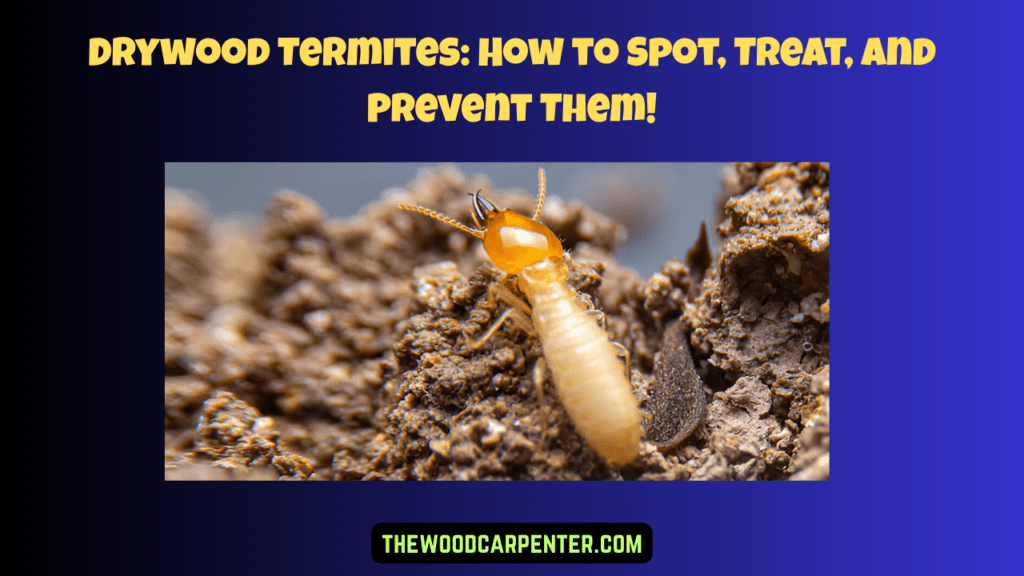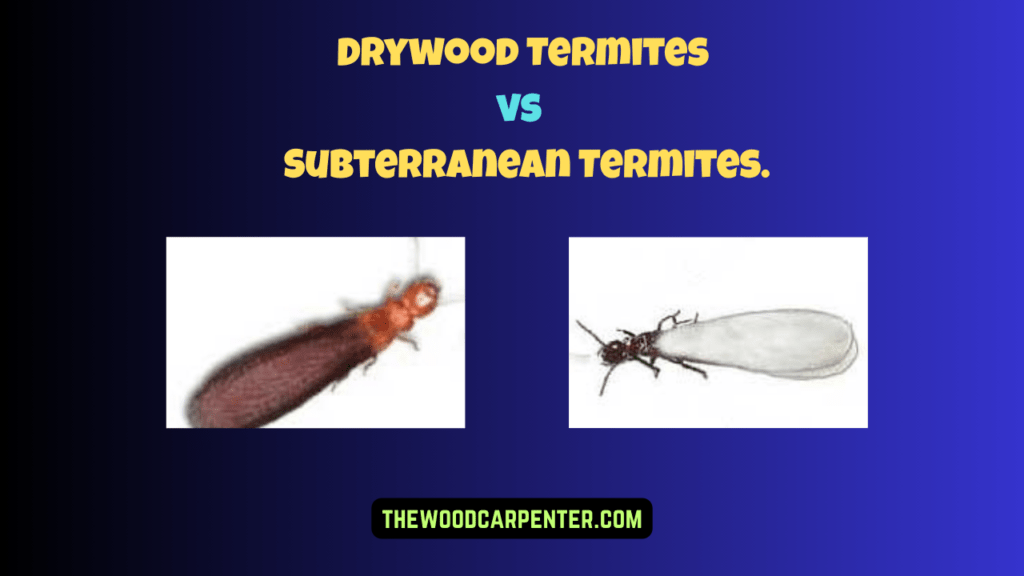
Drywood termites are one of the most damaging pests that can get into your home. They quietly eat away at wooden furniture and structures, often without being noticed until serious damage is done.
Unlike other termites that live in the ground, drywood termites live inside dry wood and don’t need contact with soil or moisture to survive. That makes them harder to find and get rid of.
This simple guide will help you understand drywood termites, including how to spot them, how to prevent them, how to treat an infestation, and the warning signs to watch out for.
Understanding Drywood Termites
What Are Drywood Termites?
Drywood termites are insects that live in and feed on dry wood. You might find them in wooden beams, furniture, or even picture frames. They don’t live in the soil like some other termites and don’t need extra water—they get everything they need from the wood they eat. Their colonies are usually small, with up to about 2,700 termites living together.
Physical Characteristics:
| Feature | Description |
| Color | Creamy white to light brown |
| Size | 3/8 to 1 inch long |
| Shape | Long, narrow, oval body |
| Legs | 6 |
| Antennae | Straight |
| Wings | Swarmers have two pairs of equal-length wings, quickly shed after swarming |
How Do Drywood Termites Get Into Your Home?
Drywood termites often sneak into homes through things like old furniture, wooden structures, or firewood.
They usually enter through small cracks in walls, windows, or the roof. Once they’re inside, they find dry wood, settle in, and start building a colony that can grow over time.
Also read:
Carpenter Ants vs Termites: Which One’s Worse?
Wood-Boring Beetles: Identification, Damage, and Control
Carpenter Ants ? Here’s How to Get Rid of Them
Where Are Drywood Termites Found?
Drywood termites are mostly found in warm coastal and southern parts of the U.S., such as California, Florida, Hawaii, Texas, and the Carolinas. They often attack attic wood, wooden siding, window and door trim, and furniture.
Signs That You Might Have Drywood Termites
Catching a termite problem early is important because they can do a lot of damage before you even notice them. Here are some common signs to look for:
- Termite Droppings (Frass): Drywood termites leave behind small, dry droppings that look like sawdust or tiny grains of sand. These usually pile up near where they’re active.
- Hollow-Sounding Wood: If you tap on wood that’s infested, it may sound hollow because termites have eaten away the inside.
- Dropped Wings: After flying termites (called swarmers) land, they shed their wings. You might find piles of wings near windows or lights.
- Clicking Sounds: Sometimes, you can hear quiet clicking or tapping noises coming from inside the walls or wood. That could be termites.
- Hard-to-Open Windows or Doors: As termites eat the wood, it can warp, making doors or windows stick or become hard to open and close.
- Flying Termites (Swarmers): You may see flying termites around your home, usually in late summer to early fall. This is a strong sign that termites are nearby.
Why Are Drywood Termites dangerous?
Drywood termites are dangerous because they can hide inside wood for a long time without being noticed. They eat wood slowly, but over time, they can cause serious damage to important parts of your home, like beams and support columns. If the problem gets bad, it can lead to expensive repairs.
How to Keep Drywood Termites Out
You can help protect your home from drywood termites by taking these simple steps:
Seal Cracks and Gaps: Use caulk to seal any cracks or holes in your walls, roof, and around pipes or wires that enter your home.
Protect Wood Surfaces: Keep outside wood—like siding, trim, or decks—painted or sealed. Fix peeling paint right away.
Store Wood Correctly: Keep firewood, scrap wood, and lumber at least 20 feet away from your home and off the ground.
Fix Moisture Problems: Termites like damp areas. Repair any leaks, make sure rainwater drains away from your house, and keep your attic and crawl spaces well-ventilated.
Trim Plants Around Your Home: Keep bushes and trees at least 12 inches away from your home. This helps air flow and makes it harder for termites to hide.
Get Regular Inspections: Have a termite professional check your home once a year. Also, keep an eye out for any warning signs yourself.
Treatment Options for Drywood Termites
If you find drywood termites in your home, it’s important to act quickly. The right treatment depends on how bad the infestation is. Here are your main options:
1. Spot Treatments (For Small Infestations)
Direct Wood Treatment: A professional can drill small holes into the wood and inject termite-killing products (like borate solutions or foam sprays) into the area where the termites are living. This works well if the problem is small and limited to one area.
Boric Acid: You can also try using boric acid, a cheaper and safer home remedy. It can be put into holes in the wood, but it usually works slower and might not reach all the termites.
2. Whole-House Fumigation (For Big Infestations)
Fumigation (Tenting): If termites are spread throughout the house or are hiding in hard-to-reach areas, fumigation is usually the best choice. Professionals cover your whole home with a tent and fill it with gas that kills termites deep inside the wood. You and your pets will need to stay out of the house for a few days.
3. Replacing Damaged Wood
If the wood is badly damaged and no longer safe, it may need to be removed and replaced. It’s a good idea to treat the new wood with termite protection (like a borate solution) before installing it.
4. Preventive Treatments
When building or remodeling, you can apply termite-resistant products (such as borate-based sprays) to exposed wood. This helps protect the wood from future termite attacks.
Comparison: Drywood vs. Subterranean Termites.

| Feature | Drywood Termites | Subterranean Termites |
| Nest Location | Inside dry wood | In soil, require moisture |
| Mud Tubes | Absent | Present |
| Colony Size | Up to 2,700 | Up to millions |
| Entry Points | Cracks, wood joints | Through soil, foundation |
| Damage Pattern | Smooth, erratic galleries | Rough, with mud lining |
| Treatment Focus | Wood treatments, fumigation | Soil barriers, baiting |
Drywood Termite Prevention in New Homes
Building a new home? Here are some tips to prevent drywood termite infestations during construction:
1. Use Pressure-Treated Wood
Opt for pressure-treated wood, which is less attractive to termites. This is especially important for areas like framing and exterior wood components.
2. Install Termite Barriers
Termite barriers, such as physical and chemical barriers, can be installed during construction to prevent termite access.
3. Regular Inspections
Even with preventative measures in place, regular inspections are important to ensure that termites don’t find their way into your home.
Conclusion: Protect Your Home from Drywood Termites
Drywood termites are persistent pests that can cause extensive damage to your property. Identifying the signs early and taking preventative measures is crucial to avoiding infestations.
Whether through regular inspections, fumigation, or localized treatments, there are effective ways to control and eliminate drywood termites. Be proactive, and protect your home from these destructive pests before it’s too late.
FAQs
1. How do drywood termites differ from subterranean termites?
Drywood termites live in dry wood and don’t need contact with the ground, while subterranean termites live in the soil and need moisture to survive.
2. Can I treat drywood termites myself?
Yes, but for larger infestations, it’s recommended to hire a professional pest control service for more effective treatment options.
3. How can I tell if my furniture has drywood termites?
Look for small holes, sawdust-like frass, or a hollow sound when tapping on the wood.
4. Is fumigation the best treatment for drywood termites?
Fumigation is an effective treatment, especially for severe infestations, but it may not be necessary for minor ones.
5. How often should I inspect my home for termites?
It’s recommended to have an annual inspection to detect termites early and prevent potential damage.

